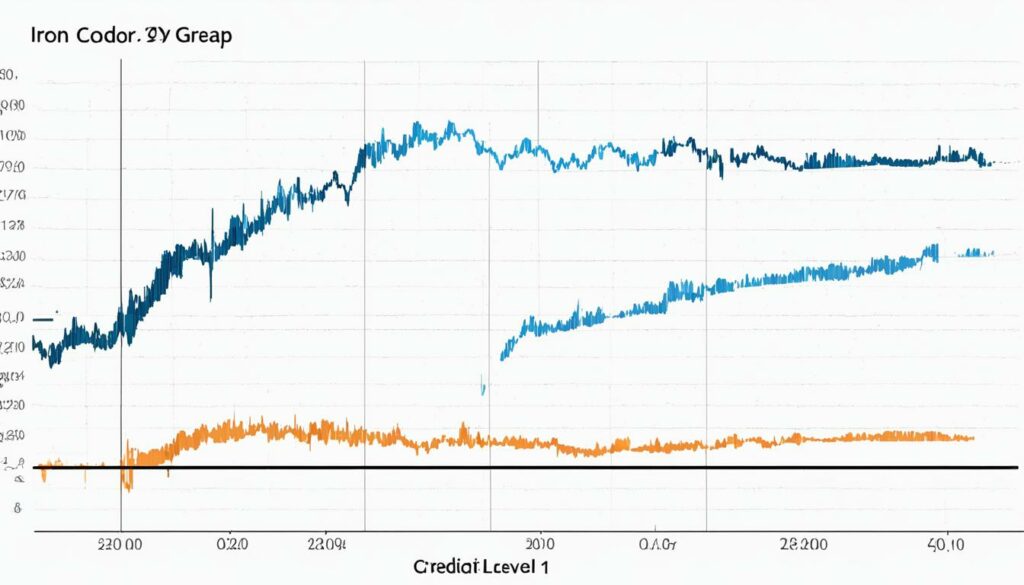Difference Between Iron Condor and Credit Spread

When it comes to options trading, there are various strategies that traders can employ to maximize their returns. Two popular strategies are the iron condor and the credit spread. While both strategies have their advantages, it’s important to understand the differences between them and the suitable market conditions for each.
An iron condor is an advanced option strategy that offers consistent returns and is favored by traders who want to minimize the time spent on trades. It is a neutral position that provides a high probability of return when executed correctly. On the other hand, a credit spread is a strategy that involves selling one option and buying another option with different strike prices.
The construction, risk profile, and profit potential of these strategies differ significantly. An iron condor is created by constructing two credit spreads – a bear call spread and a bull put spread. This strategy establishes a trading range based on the strike prices of the sold options and can be profitable when the underlying security rises, falls, or trades sideways. On the other hand, a credit spread can be used to take advantage of volatility or implied volatility. It can be constructed with call options or put options and aims to generate income through collecting premiums from the sold options.
Traders considering these strategies should carefully evaluate their risk tolerance, time commitment, and trading goals. The decision between iron condors and credit spreads will depend on factors such as the trader’s preferred market conditions, workload, stress level, and probability of success. By understanding the key differences, traders can make informed decisions to optimize their options trading strategies.
Key Takeaways:
- An iron condor is an advanced option strategy that provides consistent returns in suitable market conditions.
- A credit spread involves selling one option and buying another option with different strike prices to take advantage of volatility.
- Iron condors require more time and effort to monitor and manage compared to credit spreads.
- Traders should consider their risk tolerance, time commitment, and trading goals when choosing between these strategies.
- Understanding the key differences can help traders optimize their options trading strategies.
Understanding Iron Condor
An iron condor is a popular options trading strategy that allows traders to benefit from a neutral market position. It involves using two credit spreads – a bear call spread and a bull put spread – to establish a trading range for the underlying security.
In a bear call spread, a trader sells a call option at a certain strike price (lower strike) and simultaneously buys a call option with a higher strike price. This strategy profits when the underlying security remains below the sold call option’s strike price, as the options expire worthless.
Example: Sell XYZ call option with a strike price of $50 and buy XYZ call option with a strike price of $55.
Similarly, a bull put spread involves selling a put option at a certain strike price (higher strike) and buying a put option with a lower strike price. This strategy profits when the underlying security remains above the sold put option’s strike price, allowing the options to expire worthless.
Example: Sell XYZ put option with a strike price of $45 and buy XYZ put option with a strike price of $40.
The combination of these two credit spreads forms the iron condor strategy, which establishes a trading range based on the strike prices of the sold options. This range reflects the neutral position of the strategy, as it profits when the underlying security trades within the established range (between the call and put strike prices).
It’s important to note that while the iron condor strategy offers limited profit potential, it also comes with limited risk. Losses are incurred if the underlying security surpasses the call strike or falls below the put strike, as the options may be exercised and result in potential losses. However, the risk is capped compared to the potential profit, making it a suitable strategy for traders seeking risk management.
To visually represent the iron condor strategy and its trading range, refer to the table below:
| Call Options | ||
|---|---|---|
| Put Options | Sold Call Option (Lower Strike) | Bought Call Option (Higher Strike) |
| Sold Put Option (Higher Strike) | Bought Put Option (Lower Strike) | |

Exploring Credit Spread
A credit spread is a popular options trading strategy that involves selling one option and buying another option with different strike prices. This strategy can be used to take advantage of volatility or implied volatility in the market.
There are two types of credit spreads: call credit spreads and put credit spreads. A call credit spread is constructed by selling a call option with a higher strike price and buying a call option with a lower strike price. On the other hand, a put credit spread entails selling a put option with a higher strike price and buying a put option with a lower strike price.
The risk profile of a credit spread is determined by the width of the spread between the two strike prices. The wider the spread, the higher the potential profit, but also the greater the potential loss. However, the potential loss is limited to the width of the spread minus the credit received when entering the trade.
One of the main advantages of a credit spread strategy is the ability to generate income through premium collection. When selling options, traders receive premiums, which can contribute to overall portfolio returns.
Let’s take a closer look at the risk profile and profit potential of a credit spread using a table:
| Spread Width | Potential Loss | Potential Profit (Credit Received) |
|---|---|---|
| Small spread | Low | Low |
| Wide spread | High | High |
As seen in the table, a smaller spread width results in a lower potential loss and profit. Conversely, a wider spread width increases both the potential loss and profit.
In summary, credit spreads are an effective strategy for traders looking to generate income and manage risk. By utilizing the volatility or implied volatility in the market, credit spreads can offer attractive risk-reward profiles. It is important for traders to thoroughly understand the risk profile and potential loss of credit spreads before executing trades.

Iron Condor vs Credit Spread: Key Differences
When comparing iron condor and credit spreads, it’s crucial to understand their differing risk and reward profiles. The maximum profit potential and loss vary significantly between these strategies, with the strike price and underlying stock price serving as key differentiators. Moreover, recognizing the disparity in risk tolerance is essential when assessing iron condor and credit spreads for options trading strategies. Understanding these discrepancies can greatly impact investment advice and decision-making, highlighting the expertise needed to navigate the complexities of vertical credit spreads, bull call spread, put option, and other NLP-related terms effectively.
Market Outlook for Both Strategies
Assessing technical data and future results is crucial to determine the market outlook for both the iron condor and credit spread strategies. Understanding the underlying asset, intrinsic value, and evaluating the expiration date are essential factors in predicting the market outlook for these options strategies. Additionally, considering investment objectives and seeking professional advice play a crucial role in gauging the market outlook for both strategies. Analyzing the market outlook is fundamental for implementing these strategies effectively and maximizing the potential for profitable outcomes.
Comparing Risk and Reward
When evaluating options strategies like call spreads, put spreads, and vertical credit spreads, it’s crucial to compare the risk and reward profiles. Understanding the differences in maximum loss, short strikes, and net credit is essential for assessing the risk and reward potential of each strategy. Additionally, analyzing the underlying price, future results, and investment advice aids in comparing the reward profile and risk tolerance. By comparing these factors, investors can make informed decisions about implementing strategies like the iron condor, bull put spread, or bear call spread based on their individual risk appetite and market outlook.
Similarities between Iron Condor and Credit Spread
When comparing iron condor and credit spreads, it is important to recognize similarities in risk and reward profiles. Identifying common underlying security and spread width is crucial for both strategies. Understanding the shared elements of max profit, max loss, and short option is essential. Recognizing neutral and bullish strategies as common factors aids in comparing iron condor and credit spreads. Evaluating long put, long call, and later expiration date helps identify similarities between the two strategies. Recognizing these shared elements is crucial for implementing a successful NLP-based investment advice for both vertical credit spreads and options strategies.
Aim of both Strategies
When implementing call spread and put spread strategies, the primary goal is to generate income from options trading. Mitigating risk and maximizing profit potential are crucial objectives. Both strategies aim to capitalize on neutral strategies and the underlying security, optimizing options trading strategy by creating a balance between maximum profit and risk tolerance. This involves understanding short strikes, maximum loss, bull put, bear call spread, iron condor strategy, investment advice, and vertical credit spreads. By assessing these elements, investors can make informed decisions and enhance their options trading approach.
Situations where both are beneficial
In neutral and stable market conditions, both the iron condor and credit spreads prove beneficial. Implementing them in options trading is advantageous for risk mitigation. Capitalizing on the underlying stock price and spread width makes them favorable, aiming for maximum profit and risk tolerance. They are useful when executing options strategies and investment objectives, balancing profit and risk. Maximizing profit potential and managing risk are key objectives common to both strategies. Recognizing the similarities in their risk and reward profiles is crucial for evaluating their benefits in various market situations.
What should be considered before choosing between Iron Condor and Credit Spread?
Before deciding between an Iron Condor and a Credit Spread, it’s crucial to consider investment objectives and seek advice. Evaluate the underlying security, strike price, and expiration date. Understand net credit, intrinsic value, and maximum value. Assess options strategies, underlying price, and technical data. Evaluate risk tolerance, maximum risk, and maximum profit potential.
Conclusion
In conclusion, both the Iron Condor and Credit Spread options strategies have their unique characteristics and benefits. The choice between the two ultimately depends on your market outlook, risk tolerance, and investment goals. While the Iron Condor offers a wider profit range and lower margin requirements, the Credit Spread provides a higher potential return on investment. It is important to carefully consider your individual circumstances and conduct thorough research before deciding which strategy is best suited for your trading needs. Consulting with a financial advisor or professional can also provide valuable insights and guidance in making an informed decision.







